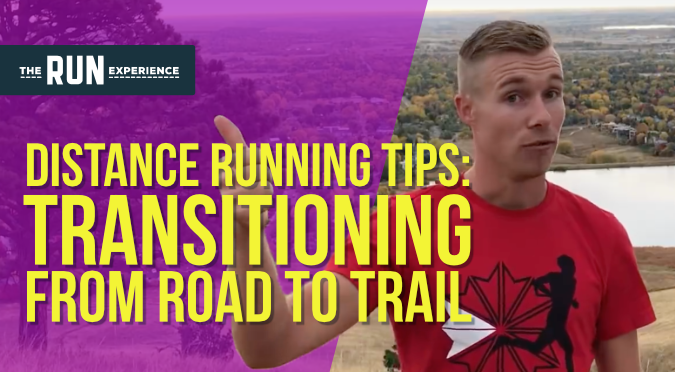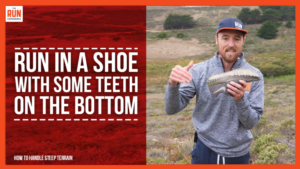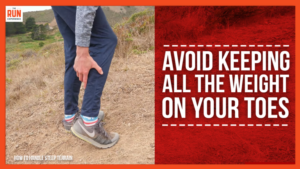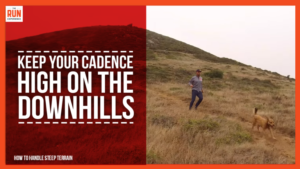19 Trail Running Tips for Beginners, Pros, & (Really) Anyone
Trail running is different compared to road running. Use these simple trail running tips for beginners to learn how to start trail running.

New to trail running? These trail running tips and tricks will help get you up to speed (literally) in no time.
If you’ve been running for at least a couple of months, it’s possible you’ve gotten stuck in a rut and are getting bored with your usual route, especially if you do a lot of road running. But have you ever thought of opting for trail running? Or you are not aware of how to start trail running? Well, it’s time to shake up the routine, consider adding a trail run to your weekly running schedule.
Trail running is full of variation and surprise. No matter where you are or where you’re headed, you’re practically guaranteed to find a hill you need to either climb or descend. If you don’t run into one of those, you’ll at least have to navigate around some rocks, tree stumps, a stream, or even some wildlife.
Read on for our top tips for how to start trail running!
Do You Need Trail Running Tips to be a Good Trail Runner?
Trail running can be thrilling and adventurous, but it also presents unique challenges that differentiate it from road running. Whether you are transitioning from the road to rugged trails or starting fresh on the trails, you'll want to know these trail running tips before you get to far down the path.
Here's why:
- Safety First: Trail running often involves navigating uneven terrain, sharp inclines, potential hazards like roots, rocks, and branches, and sometimes even wildlife encounters. Knowledge of trail running safety, such as how to run on uneven ground without injury and what to carry for emergency situations, is indispensable.
- Technique Matters: Unlike the consistent, flat surfaces of road running, trails require a varied running technique. Tips on maintaining stability, proper foot placement, and body positioning can prevent falls and injuries while improving efficiency. Learning how to tackle steep ascents and descents correctly is also part of trail running that can be vastly different from any road technique.
- Gear Essentials: Using the correct gear can make a significant difference in your trail running experience. Trail-specific shoes with appropriate grip and support, hydration packs suited for longer runs in remote areas, and clothing that protects against the elements are all crucial. Tips on selecting the right gear can enhance comfort, performance, and protection.
- Environmental Respect: Trail running tips often include best practices for minimizing your impact on the natural environment. Understanding trail etiquette, such as right-of-way, how to pass other trail users respectfully, and principles like "Leave No Trace," ensures that the trails remain beautiful and accessible for everyone.
- Adaptation and Enjoyment: Tips can help you adapt to trail running more quickly, enhancing your enjoyment and helping you to appreciate the unique aspects of running in nature. They can teach you how to read trail markers, adjust your pace according to terrain, and even how to use natural features to your advantage.
19 Trail Running Tips for Beginners
Don’t worry if you’re new to trail running—in the end, it’s not too different than running anywhere else. These trail running tips were organized to take you from zero to hero on the dirt and rocks.
Follow these trail running tips for beginners to avoid injury and enjoy running in nature faster and longer.
1. Find the Running Trails
First things first when getting started with trail running…you have to know where the trails are! There are several tools you can use to discover the trail network around you. A great place to start is your local running or outdoor adventure store. Chances are they’ll be able to clue you into the popular local trails, and they might even organize weekly or monthly running events with a running club that has a trail-running group that you can take advantage of to meet other trail runners and start off with a group.
Your next best option is to hit the internet! There are some great websites and apps that have a whole catalog of trails where you live, such as AllTrails and Trail Run Project. Both sites allow for the trail user to upload their reviews and photos of the trails, which can help you decide which one to tackle first. If you live near a national park, visit their website to learn about the running trails.
2. Pick the Right Trail Running Shoes

On a steep trail with loose gravel, tree roots, and other obstacles, you’ll be wise to invest in a trail running shoe with some teeth on the bottom. Your road shoes just won’t cut it here and could make you think steep trails are tougher efforts than they need to be.
It is important that your shoe can hold onto the trail. Depending on what you’ll be encountering–mud, gravel, wet rocks, sand, etc. It will affect what type of trail shoe you use. Different shoes are better for different terrain, so just as with your other gear or nutrition, some experimentation might be necessary.
Also, keep the time of year in mind. A trail might be less slippery if it’s been raining a bit because the moisture helps pack together with the dirt and gravel.
Dry trails are often more slippery because things are free to move around. However, if it’s so wet that the dirt has turned into slippery mud, it may be even worse.
3. Always Carry a Light for Trail Runs
If you spend any time on the trail before sunrise or nearing sundown, you’d be wise to carry a light source with you. There are many options from headlamps to flashlights to waist lights; it’s just a matter of finding the one that works for you.
4. Don’t Forget a Watch
If you’re a regular road runner, you might already have a watch or other way to track your distance. If not, a GPS device can be a great way to track your mileage, the record just how much elevation you gained going up and down those hills, and some can even point you back to the trailhead if you get turned around mid-run.
5. Bring a Pack or Handheld
Since you won’t be stopping by water fountains on the sidewalk, having a method for keeping some water and a gel or bar with you is important. Whether you spring for a hydration pack or get by with just a handheld bottle, make sure you’ve got a way to carry the water you need for your distance.
6. Put on Some Gaiters (Maybe)
If your trail has lots of sand, pine needles, or other grit that can find its way into your shoe, gaiters are a great investment to provide some extra protection. You won’t have to stop to empty out your shoe once you’ve got a pair snug around your ankles!
Pro-tip: Consider carrying a cell phone, just in case you happen to get lost or get injured on the trail.
7. Check Your Pace and Effort
Moving from the road to the trail can alter not only your gear list but also your running form and technique. Whereas the road or sidewalk can be a straight path with good visibility, the trail can hide loose rocks, tree roots, and general variations of ups and downs of the path.
When considering your first trail distance, it’s best to start out with the mileage you are familiar with, and maybe even go a mile or two less than that. Your typical run is going to take longer on the trails as you slow to navigate hills or uneven terrain or pause to take a picture of the view.
Rather than focusing on time and pace, keep your focus on your effort instead. It’ll be a much more accurate gauge of your run than continually monitoring your GPS or watch. Your pace will change frequently to match the section of trail you’re on, so use your own sense of energy output as your guide. Try walking the hills so you’re ready to pick it back up on the downhill and flat sections.
8. Maintain Good Form
Your best bet to staying upright and moving smoothly is to scan the ground 10-15 feet in front of you so you can pick out a path before you even get there. It can be tempting to look right at your feet, especially on rocky or rooty sections of trail, but that can lead to poor running posture and a lack of awareness of your surroundings. Walking or running uphill can also alter your form to an extent, requiring you to power yourself up with your arms, or to skate down the hill by keeping your feet right under your body.
9. Work on Your Foot Position

The first common mistake runners can make while tackling a steep trail is to keep the weight on the toes. While it may feel more powerful to attack the hill on your toes, you need to save your calves for the rest of the run.
Though the calves have some good power in them to propel you upward, they won’t take the uphill punishment forever. If you keep constant tension on them while moving up the incline, eventually they’ll rebel and cramp up on you.
In order to avoid burning out those calves, your heels need to briefly touch the ground with each stride. Think of it as a quick kiss to the trail, rather than firmly settling your heel down each time. This may feel more difficult than usual because running uphill requires more dorsal flexion in the foot.
To accommodate this, hinge forward slightly at your hips. This way your heels can touch the ground more easily. Be sure to keep your core tight to avoid throwing off your posture here. No slumping forward!
10. Keep Your Eyes Up
This seems like an obvious downhill tip, but look ahead! Try to focus on what lies ahead so that you can adequately prepare for it. Just like when you’re driving a car, you’re not looking directly in front of you. Instead, you’re scanning the road ahead of you to watch out for traffic coming into your lane or a piece of litter about to blow in front of you.
Alternate looking at the terrain you are currently running over and what’s up next, and keep switching back and forth to ensure you’re ready what’s to come.
With this strategy, you’re less likely to catch your toe on a root or to not see the upcoming section of loose gravel that’ll send you for a spin.
11. Maintain a High Cadence

It can be tempting going downhill to take an easy pace. For most downhills, this is doing you a disservice.
First, it’s putting a lot of pressure on your quads, a muscle group you will desperately need on the next uphill portion of the race. Instead of taking slow, heavy steps to plod your way down, think about “fast feet.”
Keep your impact with the trail light and quick to minimize your time on the ground. This type of quick-stepping will help reduce the beating your legs take as well as keeping your cadence higher and lighter.
In addition, keeping a high cadence reduces the likelihood of stumbling. By picking your feet up and turning them over more quickly, you are less likely to drag your feet behind you and accidentally trip on something (speaking from experience!)
12. Keep Your Center of Gravity Forward
Our bodies’ natural tendency when going downhill is to lean back like we’re putting on the breaks. This actually increases the likelihood that we will slip.
With less weight directly over our feet, they are more likely to slip out from under us as we’re moving. By staying upright or slightly leaning forward, you keep more of your weight centered over your feet, which increases your stability.
13. Practice Your Trail Running Technique
It’s important not to descend beyond your ability. This means that while the tips above are certainly going to improve your downhill running, you don’t want the first time you try them to be on race day.
Start practicing descending in your training, just as you practice running uphill. For downhill repeats, try to descend quickly and lightly, employing the strategies mentioned above. When you’re climbing back up to the top of the hill to descend again, take it easy.
You don’t need to push the effort on the uphill as well as the downhill, so use the trip back up as your recovery.
If you can, practice the specific downhills you will be running on race day many times beforehand. The more familiar you are with the hills, the higher you can safely keep your cadence, and the less afraid you will be to keep your body weight forward.
Practicing downhills is the only way to ensure your safety come race day.
14. Prioritize Recovery
Even if you don’t push the mileage or effort, it’s likely you’ll be a bit sore afterward just based on the terrain and effort of the trails. A great way to finish up your run is to spend some time with your foam roller. We recommend (at least) 10 minutes of post-run mobility to start, especially to hit all those muscles that just supported you on the trails: quads, calves, ankles, and feet. Follow that up with a few quality stretches and you’ll be ready to hit your next run or workout feeling great.
15. Choose the Right Time to Run and Walk
The first common mistake here is to run too long. It can be a tough thing to allow yourself to walk, especially if it’s early in the trail race. You might be caught up in the field of runners and not want to be the one to drop down to a hiking pace.
However, if your heart rate spikes too high, it is going to take too long to recover from that feeling, and by the middle or end of your race, you’ll be totally gassed.
If you’re on a training run, it might sound like a good idea to just attack the hill. After all, the more you run, the faster you’re done, right? And your Strava segment will know you slowed down! Now, now, don’t get caught up in the numbers.
Any time you save by running hard early on can easily–and most likely will–be lost later in your run when the jelly legs set in and you have to walk a section that would otherwise have been runnable. Trust me, I’ve been there!
But Don’t Walk for Too Long
The second common mistake is to let yourself walk for too long. Be tough on yourself here. This walk break isn’t a mosey or a rest. It’s a strategic break to keep moving forward while allowing your body to recover or to get across terrain that you can’t safely run.
Walk only when you know you need to, and start running as soon as you can after that. You can always return to walking if you got going too soon, but the goal should always be to get back to running as soon as possible.
16. Properly Fuel and Hydrate
Given that your runs on the trail can take more time and effort than being on the road, it’s a good idea to take along some fuel and hydration so you don’t hit empty while out there. Some folks prefer to take along water and gels or real food, while others prefer “liquid nutrition,” which is usually a powder that you mix into your handheld water bottle.
Figuring out what works best for you can take some trial and error, but there’s an option for every runner and every run. Whether it’s water and a banana, liquid nutrition, or a combination of the two, you’ll find what your body prefers to keep you charging up the hills.
17. Be Courteous to Other Trail Users
While out there, keep a few general etiquette rules in mind:
“Pack it in, pack it out.” Don’t leave any gel wrappers or TP out on the trail. Keeping the trails in good condition means more people can use them without having to step around or pick up someone else’s junk. Littering is lame!
Yield to whoever is going faster than you. If there’s a runner coming up behind you, scoot over so they can pass you. If a mountain bike is approaching in front of you or from behind, give them enough room to safely pass.
Obey the leash laws of the trail if you like to run with your dog.
18. Join a Trail Race
Once you get a taste for the trails, you just might become a convert! Though certainly not a requirement, running a trail race can be a great way to stay motivated in training, meet new people, and check out new trails.
Ultrasignup is a comprehensive site to find races according to location, distance, date, and more. No matter the type of race you’re looking for, you’ll be able to find it here.
This is also another great opportunity to talk to your local running store to see if they put on any races, or if the staff volunteer at races in the area.
19. Ease into Trail Running
If you’re brand new to trail running, give your body time to adapt. It takes different muscles to stabilize on different terrain, and steep ups and downs are going to take a toll on your calves and quads.
Give your body time to adapt. Don’t try to convert your road mileage to trail mileage—it doesn’t work like that.
Put These Trail Running Tips to Good Use
Reading about the best trail running tips is a great first step, but now it’s time to go do something about it. Open up your favorite trail app (or just walk outside) and find some good trails. Ease into to allow your body time to adapt to the new stimulus.
We’ve got plenty more training tips and programs for you! From injury prevention to full race distance plans, check out the running training plans, our subscription service to a full library of tools and plans to help you become the runner you want to be.
